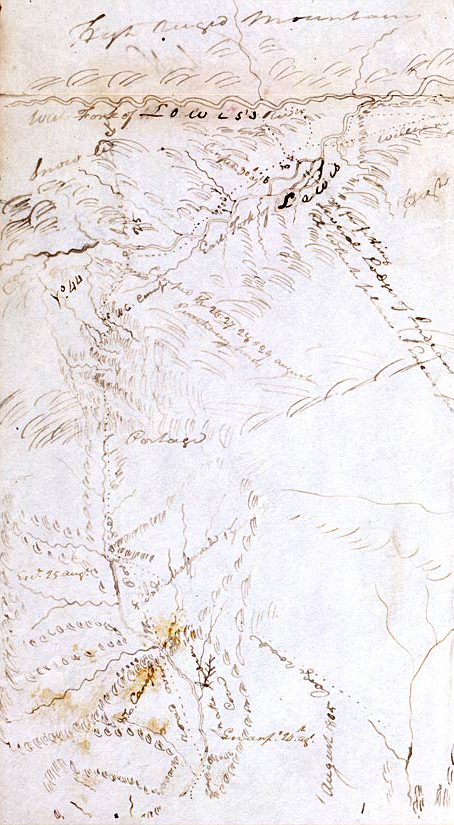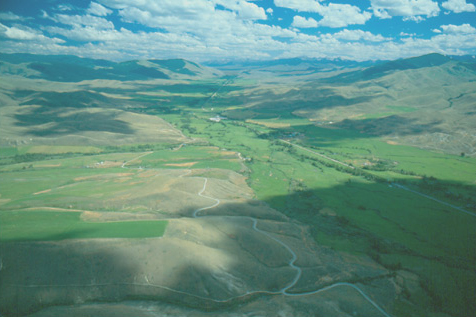After searching a month without success, Lewis was finally meeting the Lemhi Shoshones, the people his expedition required to continue to the Pacific Ocean.
At long last, on a “wavy plain” above the river valley, a few more Lemhi Shoshones came in sight. Making all the benevolent signs and sounds he could think of, pondering ways to bring the wary Indians within talking distance, Lewis finally touched the hand of an elderly woman, and the spark of international friendship was struck. Soon he was confronted with the charge of a squadron of 60 Indian dragoons. He stood his ground, weaponless, holding the American flag to the breeze. The old woman told the warriors’ leader of her impression of the strangers, and the principal chief, mollified, introduced himself as “Ca-me-âh-wait.” Through the medium of Drouillard’s sign-language Lewis understood that the name meant “one who never walks,” but literally it was “I will not go.”[1]Leo Ariwite, Sr., an elder of the Lemhi-Shoshone Tribe; personal communication from Kel Ariwite, 4 November 2004. Other spellings and translations of the chief’s name are discussed in John E. … Continue reading His war name was Too-et’-te-con’-e or Black Gun. Lewis explained:
These people have many names in the course of their lives, particularly if they become distinguished characters. for it seems that every important event by which they happen to distinguish themselves intitles them to claim another name which is generally scelected by themselves and confirmed by the nation.
Lewis soon learned of the tribe’s underlying political structure. In fact, he was told, “every man is a chief, but all have not an equal influence on the minds of the other members of the community, and he who happens to enjoy the greatest share of confidence is the principal Chief.” In other words, this was a democratic society.
Duets of whispered âh-hi’-e—”I am much pleased”—embellished “the national hug,” then the young chief led the grand procession homeward. Seated on green boughs and the skins of antelopes in the shelter of the single leather lodge they had left after the Atsinas‘ surprise attack last spring, Lewis and his companions shared friendly smoke with Cameahwait and his retinue, barefoot to betoken mutual sincerity. In the grandest gesture of all, the Shoshone chief exchanged names with his American counterpart.
After the speeches, the pipe, and a “hearty meal” of serviceberry and chokecherry cakes, the Shoshones danced for their guests. Lewis excused himself at midnight and headed for his private willow-brush lodge. A neighbor summoned him to his own “bower,” and gave him “a small morsel of the flesh of an antelope boiled, and a peice of fresh salmon roasted.” This, Lewis declared, was the first salmon he had seen, and it “perfectly convinced me that we were on the waters of the Pacific Ocean.”
The party continued throughout the night. “I was several times awoke in the course of the night by their yells,” Lewis admitted, “but was too much fortiegued to be deprived of a tolerable sound night’s repose.” Still mindful of details, he added, “I observe no essential difference between the music and manner of dancing among this nation and those of the Missouri.”
Lemhi River Valley
To see labels, point to the image.
© 2001 Airphoto, Jim Wark. All rights reserved.
This view looks 6.5 degrees south of south-southeast (164° TN) toward the upper Lemhi Valley.
Lewis spent another day at Cameahwait’s village, asking questions, listening, and learning all he could absorb about the geography of the Shoshones’ homeland and the possible ways westward. Immediately he formulated a general plan for proceeding overland if the information about the river proved true. Obedient to Jefferson’s orders, he also queried Cameahwait about his people’s geopolitical situation, especially their relations with the Spanish colonists to the south. Above all, he emphasized his appeal for help in carrying their baggage from the headwaters of the Missouri across the “gap” in the “deviding Mountain.” Cameahwait harangued his people convincingly, and they agreed to cooperate.
However, by the next morning, the 15th, a change of heart bred an atmosphere of suspicion that darkened the otherwise beautiful day. Lewis’s Ciceronian rhetoric began with the dubious argument that “among whitemen it was considered disgracefull to lye or entrap an enimy by falsehood.” He taunted the Chief with intimations of cowardice—which “touched him on the right string”—and tantalized him with the promise of those approaching “canoes loaded with provisions and merchandize.” He succeeded to the degree by 12:30 p.m. he and Cameahwait started off with a few men; before they covered the first ten miles, all the men of the village—and a number of women, too—had fallen in behind them. We can imagine Lewis’s blood pressure subsiding to near-normal, since “they were now very cheerfull and gay, and two hours ago they looked as sirly as so many imps of satturn.”[2]Lewis may have meant what he wrote, but his phrase defies definition. It is more likely that he meant to write “imps of Satan,” an expression which had a long history even in his time, … Continue reading
SacaSacagaweagawea was still over on Jefferson’s River with Clark’s party, so the sole pivotal figure in the three days’ intensive conversations and negotiations was George Drouillard.
The means I had of communicating with these people was by way of Drewyer who understood perfectly the common language of jesticulation or signs which seems to be universally understood by all the Nations we have yet seen. it is true that this language is imperfect and liable to error but is much less so than would be expected. the strong parts of the ideas are seldom mistaken.
Indeed, signing was the common commercial and diplomatic language among all the tribes of the Northern Plains. Swift and sure, signing dispensed with articles, conjunctions, and subtle adjectives and adverbs. It conveyed strong, uncomplicated images and concepts in visually descriptive nouns and verbs. Its eloquence resided in its fluency and rhythm. Only individual or local dialects could make some signs ambiguous.[3]See Plains Sign Language.
Notes
| ↑1 | Leo Ariwite, Sr., an elder of the Lemhi-Shoshone Tribe; personal communication from Kel Ariwite, 4 November 2004. Other spellings and translations of the chief’s name are discussed in John E. Rees, “The Shoshoni Contribution to Lewis and Clark,” Idaho Yesterdays, 2 (Summer 1958), 2–13. |
|---|---|
| ↑2 | Lewis may have meant what he wrote, but his phrase defies definition. It is more likely that he meant to write “imps of Satan,” an expression which had a long history even in his time, and certainly makes better sense. For a fuller discussion, see Promises to Keep |
| ↑3 | See Plains Sign Language. |


